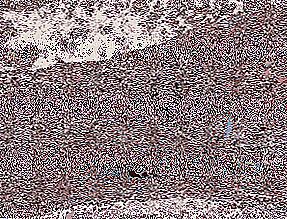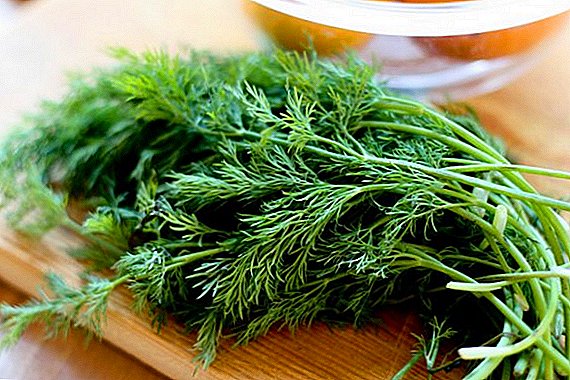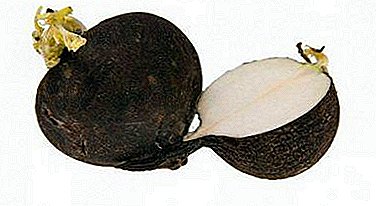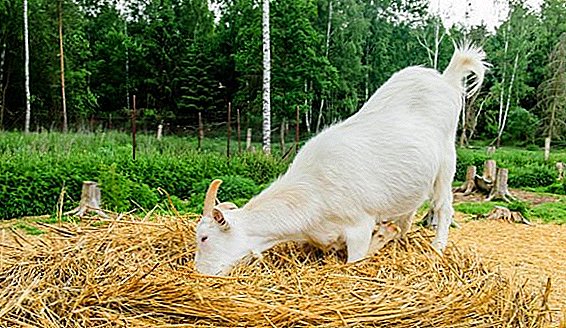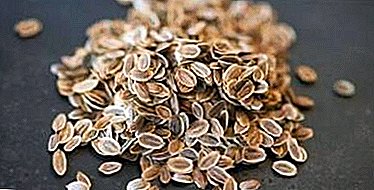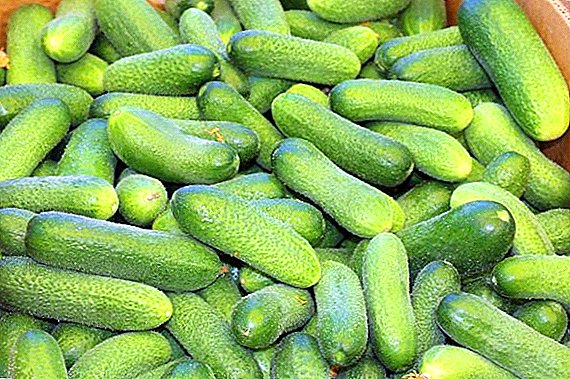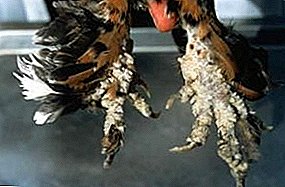
Knemidokoptoz is a disease that affects birds and is characterized by itchy skin, dermatitis, decreased productivity, and in the later stages even phalanx necrosis.
This bird acarias is characterized by lesions of the legs, which are observed due to the fact that the parasites gnaw through the skin of a kind of maze and live inside them.
Such activity of parasites leads to the fact that the horny scales covering bird legs, rise. At the same time, the skin in the area of the tarsus becomes hilly.
Mites, pathogens of the disease by their actions lead not only to the mechanical destruction of areas of the skin, but also poison the bird's body.
What is knnemidocoptosis in birds?
Kneemidokoptozom can hurt chickens and canaries, pheasants, pigeons, domestic turkeys, parrots, as well as medium-sized birds from the passerine family.
While in healthy individuals the disease is subclinical, birds experiencing stress or suffering from extraneous diseases begin to suffer from pathological changes caused by the unhindered reproduction of ticks. Such changes may affect the state of the legs, beak and cloaca.
Spread and consequences
 This insidious disease can affect birds of any age.
This insidious disease can affect birds of any age.
Ticks enter healthy individuals through contact with infected birds, or with various implements they touch.
Ticks can be activated as a result of poor conditions, the presence of dirt and damp, poor diet and stress, as well as weakened immunity.
Tumors and other diseases can provoke the development of the disease.
Knemidokoptoz can be called a seasonal diseasehowever, in parrots, as well as ornamental and songbirds, the infection can manifest itself regardless of the season. But wild or home-dwelling poultry can suffer from aggravations of knemidocoptosis in spring and summer.
In the cold season, ticks reproduce with reluctance and do not behave very actively, so there are no obvious symptoms of the disease in sick birds.
However, part of the mites can successfully overwinter and replicate again. That is why experts recommend every spring to examine chickens and send suspicious birds for analysis.
Ticks are not adapted for life on human skin, but they can live in the external environment for about seven days and easily migrate to the skin of healthy birds through touch.
This disease has serious consequences. When a bird is infected, the tick falls into the upper layers of the epidermis.where actively reproduces. At first, the locust is affected, but the process does not stop there and goes over to the legs and beak, the area around the cloaca and the eyes, as well as all the skin areas not covered with feathers.
In a parrot infected with this disease, the skin is covered with hillocks, and the scales are covered with white bloom. The final stage of the disease can lead to inflammation of the joints, and then - to the death of the phalanges on the fingers.
Progressing, the disease leads to changes in the structure of the beak, which is deformed and becomes loose. Particularly severe cases result in a violation of the growth of the beak, which is caused by damage to its horny cover, directly in the growth zone.
Causative agents of the disease
 Knemidokoptoz is a parasitic disease that occurs only in birds and is caused by ticks belonging to the genus Knemidocoptes.
Knemidokoptoz is a parasitic disease that occurs only in birds and is caused by ticks belonging to the genus Knemidocoptes.
Most often, in the laboratory, a pathogen called Knemidocoptes mutansbut it also occurs Knnemidocoptes gallinae. The shape of these ticks is oval, and the surface of the body is painted gray with a yellowish sheen.
The largest individuals rarely exceed 0.5 mm in size, while females are much larger than males. Chitin in such ticks is covered with parallel lines and rare short setae.
The main ration of ticks is tissue fluid and skin cells, which they eat, gnawing their passages directly in the epidermis.
Females lay clutch intracutaneously. Young animals go through several stages of development, turning into an adult in a few weeks, usually 3-4. The tick is resistant to survival in the environment and can last up to 9 days, depending on the temperature and humidity.
Symptoms and effects
 In the overwhelming majority of cases, symptoms of cnemidocoptosis appear on the beak, paws, and flap; however, ticks do not disdain the skin on the head and body.
In the overwhelming majority of cases, symptoms of cnemidocoptosis appear on the beak, paws, and flap; however, ticks do not disdain the skin on the head and body.
Everywhere they go deep into the skin and gnaw through there whole labyrinths, where they settle. When bird legs are struck, this can be seen from elevated horny scales and tuberous skin in the tarsus.
Being under the scales of the feet for a long time, tick causative agent of the disease can bring the bird to inflammation and tissue necrosis, after which the legs disappear under the outgrowths of a grayish tint.
The behavior of the bird at this moment varies greatly, it constantly nibbles the legs and shuffles on the perch. Lack of treatment at this point can lead to dermatitis of the legs.
Late stages are characterized by lesion of the beak and skin, located in the area of the cloaca. Not curing the bird, you can bring it to the loss of fingers and even the entire limb as a whole.
 The small tongue has a specific appearance. some poultry farmers love it, but not all.
The small tongue has a specific appearance. some poultry farmers love it, but not all.Chicken flu has already hit many birds ... Know the enemy in the face! Save your favorites by reading this disease here.
When the mites reach the beak, they begin to make moves directly in these tissues, leading to their deformation. The bill at this time increases markedly in size and twists downward..
The process needs to be urgently stopped, because after a certain stage the changes become irreversible. After the mites have firmly settled on the body of the bird, the feathers fall out from it, and also the areas of affected skin become inflamed.
The most common symptom is an excessive accumulation of epidermis crusts at the base of the feather shaft. An infected individual begins to brush its skin and often touches itchy areas with its beak so that blood begins to flow. Parrots are often taken to pluck feathers in the affected area.
Only during the progression of the disease, which is characterized by the formation of lime-colored growths on the paws and wax of a beak, can we speak of an accurate definition of the disease.
Such growths are visually similar to icicles sticking to each other and grow in the area of the joints or between the fingers. Making a cut with a similar growth, you can see a special structure resembling a porous sponge or foam.
Disease progression
Knemidokoptoz proceeds as follows:

- First stage. Here the symptoms are poorly distinguishable, but the bird may decrease immunity;
- Easy stage. At this moment, characteristic symptoms begin to appear in the affected individual. It is at this stage that the disease is being treated. At this time, the activity of ticks leads to the appearance of visible changes, such as: growths localized in the corners of the beak, on the extremities or on the limb;
- Middle stage, leading to a sharp deterioration in the health of the bird, and the symptoms of the disease are visible to the naked eye;
- Heavy stage. This is the final stage of the development of the disease, in which the bird is recognized as extremely neglected. There may be such severe consequences as a deformed beak or inflammation of the joints, necrosis of the fingers or paws. The skin is in poor condition, feathers too. If the bird is not treated, it dies.
Diagnostics
 Diagnose knemidokoptoz can complex laboratory studies.
Diagnose knemidokoptoz can complex laboratory studies.
It is a clinical examination and microscopic examination of puncture from the affected area of the skin.
The affected areas have a fairly noticeable porous structure, which is caused by the presence of the smallest pass-holes, perfectly visible even with a conventional magnifier.
The initial stage of scabies is easy to detect with regular bird inspections, especially careful attention should be paid to the beak and the cropper, which should have a flat and smooth surface.
It is also recommended to examine the non-feathered areas near the legs and the cloaca.
Treatment
Today, the most effective and safe means recognized aversectin or novertin ointmentwhich should not be applied too often.
They rarely cause complications and are not worth much. Apply the ointment on the affected areas should be using a cotton swab, repeating this procedure every couple of days. However, you can lubricate every other day, especially if the case is very neglected.
The main thing - do not cover with ointment healthy skin, lubricating only those places where the tick settled. This recommendation is associated with a certain toxicity of the drug, which, if used extensively, can lead to bird toxicity.
Medicamentous
 Domestic chickens are subject to special medical treatment with the help of acaricidal drugs that can effectively destroy not only adult individuals, but also larvae.
Domestic chickens are subject to special medical treatment with the help of acaricidal drugs that can effectively destroy not only adult individuals, but also larvae.
For this purpose, baths are made from a warm solution of 0.1% permethrin or 0.5% cyodrin preparation, into which the feet of a sick bird are immersed for a couple of minutes.
It is recommended to hold the head and wings. A good tool based on the spray is also considered Frontlay, which is usually applied to the skin with cotton buds. So it is necessary to process the skin in a day or two, until the visual manifestations of the disease disappear.
Folk remedies
 This disease is treated and folk remedies. For example, you can use birch tar, either in pure form or in combination with kerosene.
This disease is treated and folk remedies. For example, you can use birch tar, either in pure form or in combination with kerosene.
The feet of the sick bird are immersed in the bath with this agent for a couple of minutes once a week. Such treatment can be carried out two or even three times. Well kills ticks and warm birch tar, which is convenient to apply to the skin of the bird with a brush.
If there is no tar, you can replace it with iodine mixed with glycerin in equal proportions, and treat the affected areas with this mixture about once a week. The initial stage of cnemidocoptosis is well treated with heated baths, which contain a 72% solution of soap.
Prevention
 In order to insure yourself against the reappearance of disease foci, you should mercilessly get rid of all contaminated toys and various wooden accessories, as well as mineral stones.
In order to insure yourself against the reappearance of disease foci, you should mercilessly get rid of all contaminated toys and various wooden accessories, as well as mineral stones.
All this must be re-purchased, and the cage itself must be carefully and carefully washed, and then treated several times with boiling water.
However, these measures can lead nowhere if the cell structure includes wood inserts, in which micro cracks can remain mites.
The room where the sick chickens were, should be disinfected with 5% creolin solution and several times to process the space with boiling water to surely kill ticks and their larvae. Careful and regular examinations of the livestock in order to separate sick birds from healthy ones will help reduce the risk of an epidemic.
Such measures will effectively prevent the intoxication of chickens. The house should be cleaned from time to time, as well as to adjust the diet of chickens.
As a good prevention of the disease, only high-quality and proven feed should be given. Substitute new chickens should be carefully, pre-checking the cells of her skin with the help of medical analysis.
Chickens whose age has passed for half a year should be regularly examined for the presence of characteristic symptoms.


